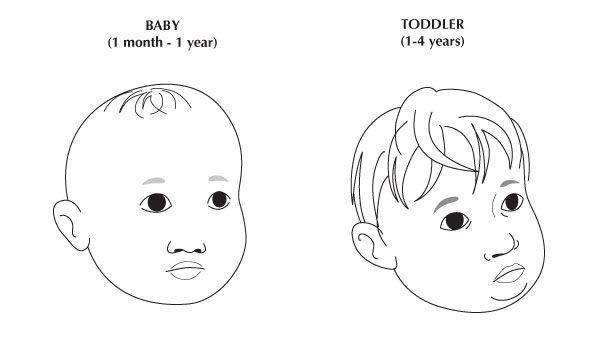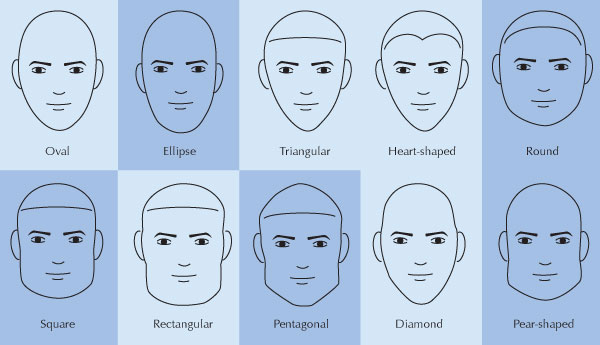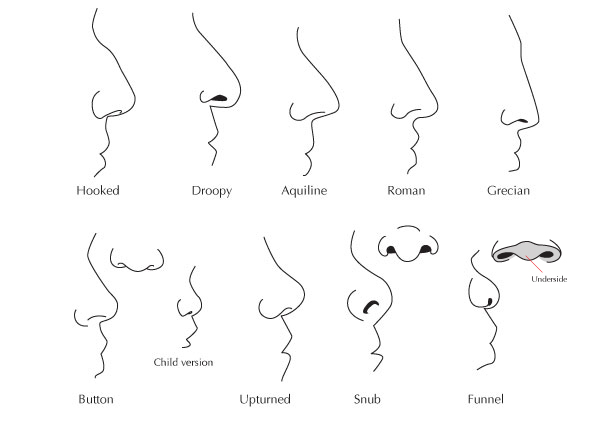
1. Male vs. Female faces
As is the case with the rest of the body, male and female faces vary from the extreme characteristics of their gender, to androgynous ambiguity. This section covers the former – the extremes of female and male features displayed in the face. Adjust in your characters as needed.
The very first difference we see between a male and a female face: how pronounced and square the male jaw is compared to the soft curve of a female jaw. Interestingly, this difference also exists in some animals, such as cats. Other lines of the face are equally harder in males: the brow juts out wile it's rounded in females, and the chin is pronounced.
A female head is overall smaller than a male head, and the neck more slender. The eyebrows are thinner and neater while the lips are fuller and of a more contrasted colour; a male's eyebrows are lower over the eyes and thicker, following the general tendency of more hair on a male body. Male lips are thinner, but the mouth is wider. The eyelashes of grown women are longer and more visible, even without makeup.

In profile we see that the female neck is not only more slender, but has a more pronounced forward movement; due to its bulk, the male neck looks more vertical. It also shows the Adam's apple, which a female neck never does.
Let's look again at the proportions of hand and foot to the face: In a male, the sole and palm are half the width of the face. The foot, including toes, is longer than the face is high, and the hand, up to fingertips, at least 3/4 of the height of the face. In a female, the width is roughly the same proportion, but the foot is just longer than the face is high, and the hand is at most 3/4 of the same height.

2. The Face and Age
Facial features and proportions change quite a bit with age, which means that being familiar with their evolution is the key to drawing people that look the age you want them to. This section offers general notes, as we are going to look at aging for the face and body, together, in great detail in a future session.
Younger Faces
Before adolescence, there is no difference between male and female faces. Before sexual dimorphism appears with the awakening of hormones, children are androgynous in face and body, and only really identified, when we think of it, by the way they are dressed and their hair is cut.
Babies and toddlers (up to four years) have no eyebrow ridge, only a gentle curve, and no visible cheekbones, but a round cheek (and often a double chin!) Baby fat is an important age marker; skinny toddlers look older than they are. The mouth is small and puckered, pouty-looking, during this time. The eyes are large and appear wide open because the upper eyelid is not noticeable yet. The eyeballs are near their adult size, but the eye slits are not, so the iris appears much larger than in adults – and the eyes are wider apart, as well. Eyebrows are only half as dark as they will be in adulthood, so they may appear absent in very fair babies.

Children (from five years old) start to show face contours and a chin, but they are still soft. The nose starts to develop a bridge, but the tip is still upturned, so it looks short. The ears on the other hand start growing faster, so they look large. The face (eyes, nose, mouth) occupies a smaller area of the head than in an adult. The neck is thin – relatively thinner than before, since the baby fat is gone, but no muscle is there to thicken it yet. The eyebrows are still high, contributing to what we call a child-like expression.
Adolescents (twelve to seventeen years of age) are in every way between childhood and adulthood, every feature being close to its adult state but still retaining something childish (to different degrees depending if an individual is closer to twelve or to seventeen).
The most noticeable difference with adult faces at this point is the size of the eyes, which are still large. The eyebrows however are now full, and lower on the eyes, so the expression changes. The nose looks longer, even if it's still slightly upturned. Also, there is now a clear difference between male and female traits. Note that you can make a girl look younger, on paper, by omitting the eyelashes; their presence in a stylized drawing immediately ages her.

Adult Faces
Young adults (eighteen to thirties) are probably the "default" age we draw, as that time of life is the most celebrated in Western culture. The features are at their peak appearance: chiselled nose, gazed toned down and matured by eyelid folds that are now visible, face contours showing more bone and muscle structure than soft flesh. Women's lips are at their most fleshy, and men's facial hair are at their strongest; dark-haired men often have a shadow around the jaw even when they’re shaved.
Late adulthood (forties and fifties) does not show dramatic change, but small ones which creep in: the eyelids get heavier, crow's feet begin to show (as well as other lines: a downward fold at the corners of the mouth, expression lines linking the latter to the wings of the nose, and possibly lines at the root of the nose. Male hairlines may start receding, though that can start happening in young adulthood.

Older Faces
In old age, from the sixties onward, all these lines increase. Worry and frown lines, as well as smile lines, become permanent. Pockets appear under the eyes. The skin loses elasticity and starts hanging at the jaws, resulting in a less firm jawline. A female's eyelashes are no longer prominent and her lips get thinner; a male's hairline recedes to a varying, but noticeable degree. The eyebrows may stay dark longer than hair (if they were dark in the first place) but they grow sparser.
The female face starts losing femininity, and by one's seventies, menopause having levelled the hormonal field, the only real difference between the two sexes is that a female's hairline recedes little while a male may be all lost by this stage. Veins, blemishes and age spots appear as the skin becomes thinner. The earlobes and tip of the nose droop. The colour of the iris loses intensity and the lips too lose colour. New lines appear above the lip and in the neck, while the cheeks are hollowed out.

3. Individual and Ethnic Variations
We know of course that the eyes, nose, mouth, even the shape of the face, all vary tremendously, and no two people (save identical twins) have the same combination of the same features. Differences in features can be conveyed even in very simple drawing styles, and are an important tool for richness of range, differentiating characters, and drawing any given character consistently over and over.
It's also important to be aware of those features that identify ethnic origin and draw them well rather than shying away from them, as skin colour is a much less important identifier than we imagine. It is the one we see consciously, but in the image below, despite total absence of any colour, the ethnicity of both is unmistakeable. The shape of the facial features overrides the complexion.

Covering facial features around the world properly would require treating every ethnotype individually as done in these charts. Here I'll just point out broad points, useful to know, with the aim of introducing diversity of features, rather than drawing specific ethnicities "accurately".
General Shape of the Face
This diagram shows the difference face shapes we perceive (they are more subtle in reality):

- Oval: A reversed egg shape, narrowest in the chin and widest in the middle.
- Ellipse: A long face almost even in width. It can be narrow or broad.
- Triangular and Heart-shaped: They are the same in terms of a face narrowest in the pointed chin and widest on top, but the one is framed by a straight hairline, the other a widow's peak.
- Round: Appears equal in length and width, with rounded jawline and hairline.
- Square: Appears equal in length and width, with squared jawline and straight hairline.
- Rectangular (or Long, or Oblong): Like Square, but longer than it is wide.
- Pentagonal: Like Rectangular, but with a narrow chin that creates more angles in the shape.
- Diamond: Narrow chin and forehead, face widest in the middle.
- Pear-shaped (or Trapezoidal): Widest at the chin and narrowest at the forehead, very full jawline.
Surprisingly enough, the skull itself gives a clue as to ethnic origin, as its morphology varies across a spectrum. on one end, the cheekbones recede to produce a narrow face: this is typical of Western types. on the other end of the spectrum, the cheekbones are prominent and project sideways, which results in a round face that appears "flat" in profile.
Compare the two skulls below and the resulting morphology in a Chinese face (Asian) and an Indian face (Caucasian). Even better, compare photos or real people, to get a fuller appreciation of how deeply carved the Caucasian face is, compared with the less dramatic Asian face – somehow like high- vs. low-relief.

The depth of the skull also varies and is classified under three main types. It's easiest to see them looking down on the head, which is admittedly an unusual angle, but they also affect the profile as shown here.
Mesocephal, the intermediate type, can be seen as the default drawing proportions we learned in our basic proportions. From this basic diagram, carve off a little volume for a brachycephal head, which is as long as it is wide, in other words round. For a dolichocephal head, which is long and narrow in comparison (longer than it is wide), add some volume to the back of the basic egg shape.

While the depth of the skull is originally population-dependent, these three types do not correspond to the three families of ethnotypes but are all found in each.
The Eyes
Eye Shapes
Here are some well-known eye shapes independent of ethnicity:

The Almond eye is characterized by the upswept lift at the outer corner. In Hoodedeyes, which can be present from birth or develop with age, a fold of skin hides the natural crease in the eyelid. In Deep-set eyes, the eyelid crease is set back so that upper eyelid is hidden in shadow. Round eyes appear more open than usual, due to more curve in the lower part. Sleepy eyes have droopy eyelids. In Downturnedeyes, the eyelid curves down at the outer corner.
One other eye shape that needs study is distinctly ethnic: the Asian eye.

The best-known identifier of Asian ethnotypes is the epicanthic fold (or epicanthal fold, or epicanthus). This is a skin fold of the upper eyelid, from the nose to the inner side of the eyebrow, that covers the inner corner of the eye. As a result the inner corner looks lower, making the eye look slanted (aka almond-shaped). How much the inner corner is covered, and how pronounced the fold is on the outer corner, both vary. When the eyes are closed, the inner corners point down noticeably.
There are two variations on the Asian eye. one is known as double-eyelid: the eyelid is creased like in Western eyes, but closer to the eyelashes. In the other, known as single-eyelid, there is no crease at all (therefore no "eyelid line" to draw), only smooth “padded” skin over the eye.
In contrast, other eyes look bigger than Asian eyes, but that’s simply due to the absence of the epicanthic fold and the constant exposure of the inner corner. In the West we can broadly say that the further North you go, the smaller the eyes are, while around the Mediterranean they are large enough to look feminine. In Western and Northern Europe there can be an external fold over the eyes (shown above) which makes them look droopy. At the very least, it shows up in old age, along with the severe wrinkling brought by age; other populations may age more smoothly (unless there’s heavy exposure to sun and wind, Asian types are notoriously smooth-skinned to a relatively advanced age).
Note that some Native American types have an epicanthic fold (it's one of the factors that indicate they descend from Asian types) while others have more Western eyes with a strong outer fold.
Eye Color
Eyes are basically either brown or blue, with green as a third, rarer type. All eye colors are pure or combined instances of the above three, sometimes with the addition of a yellow or russet pigment to the above two.

Gray is simply a variant of the blue pigment. Light gray looks nearly white, whileGray is usually tinted and appears bluish-gray or greenish-gray. Blue ranges from pale to dark. Violet eyes, very rare, are blue eyes through which red blood vessels show: the violet effect is due to this layering of blue and red.
True Green eyes, as distinct from hazel or from greenish-gray, are rare and originate in very specific populations (namely, the Irish and the Pashtun of Afghanistan). Blue-green eyes are very rare, being a simultaneous occurrence of both blue and green pigments; they can show a green ring around the pupil.
Amber eyes (not to be confused with light brown) are due to the yellow or russet pigment pigment occurring in pale green eyes. Hazel eyes are brown eyes with elements of green juxtaposed, so the two colors exist as two separate rings blending into each other. Brown then comes in a range of pale to dark. There's no such thing as "black" eyes; they are in fact very dark brown, which shows when light hits the iris directly.
Note that this table only shows the basic hues that are handed down genetically, and major incidental ones (violet, blue-green). There's a range of unpredictable “special effects” that are not genetic and not shown here: rings around the pupil or iris, speckles, etc. Also not shown is the very rare albino eye, which is pink-red because it lacks pigment altogether so that the blood vessels give it its colour.
The Nose
Basic nose shapes are shown below. All but the last two are mostly to be found in Caucasian types (defined as all types from Western Europe and North Africa to India). Indeed the nose is the most distinctive Caucasian feature as it projects well forward of the eyes, has a high root and bridge, and wings usually pressed-in. In contrast, the Asian nose is typically small, with a low nasal bridge, and minimal projection; the characteristic African nose is road and flat, with flaring wings that are merged with the ball of the nose. While Asian and African noses show the nostrils from the front, Caucasian noses more frequently show them from the sides if at all.

- Hooked: Has a broken profile
- Droopy: The tip droops very low, an effect of aging.
- Aquiline: Means "eagle-like”, in reference to the shape of an eagle's beak. In fact it has more or less pronounced convex curve.
- Roman: A very slightly aquiline shape.
- Grecian: Drops straight down from the forehead.
- Button: Rounded and small, with the tip turned up, but so slightly the nostril openings don't show. The child version is worth noting as it's common to all babies and children before their nose takes it adult shape.
- Upturned: The contrary of aquiline, a concave curve.
- Snub or Blunt or Pug: A short and upturned nose. Often found in Asian types.
- Funnel: Specific to African types, but not all African types have it!
The Lips
Here are the better-known lip shapes. They can be accentuated or even created with make-up, but females have more contrasting lips to begin with. Males display these in a more attenuated fashion (and their lips are relatively less fleshy) so they're usually not so noticeable. Also note that children's lips are thinner, less textured, and closer to the skin tone than adults.

- Natural and Pointy Natural are two variants of the basic default shape (from a Eurocentric standpoint, that is).
- Thin lips: It’s common for the upper lip alone to be thin, but the reverse is very rare.
- Cupid's Bow: An exaggerated feminine shape.
- Uni-lip: The peaks are joined in a single line.
- Beestung: a narrow and very full mouth shape, fashionable in the early 20's and usually achieved with makeup.
- Smear: Wide lips with spaced peaks, popular in the 40's.
- Glamour: The upper lip is fuller than the lower.